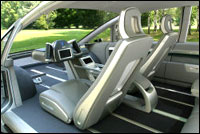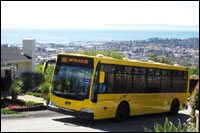
Hy-wire act.
Photo: DOE.
My daughter Maya, who is 9, saw a picture of the General Motors Hy-wire, the company’s super-sleek experimental fuel-cell car, and immediately decided we should have one. Unfortunately, I had to explain to her that the hydrogen-powered, zero-emission, fossil-fuel-free car would be perfect for us in all respects except one: It’s not available. So it goes with U.S. manufacturers and innovative, efficient automotive technology — all promise, no delivery.
So what’s an environmentally minded would-be car owner to do? First, make sure you really need a car. Motor vehicles take a heavy toll on the environment, consuming half the world’s oil and producing a quarter of its greenhouse gas emissions. Auto-making is now the largest manufacturing activity on Earth, and by 2030, there could be 1 billion cars on the planet. An increasing percentage of them will be in China, which is turning its back on the nation’s traditional transportation choice, bicycles, in favor of car ownership (bikes have even been banned from major roads in Shanghai).
Private cars, convenient though they may be, are mobile pollution factories. In one year, the average gas-powered car produces five tons of carbon dioxide, the leading contributor to global warming. Every gallon of gasoline burned up in an automobile engine sends 20 pounds of CO2 — containing five pounds of pure carbon — into the atmosphere. “It’s like tossing a five-pound bag of charcoal briquettes out my window every 20 miles or so,” writes John Ryan in his book Over Our Heads: A Local Look at Global Climate.

Get on the bus, Gus.
Photo: NREL.
Cars aren’t cheap, either. According to Asphalt Nation author Jane Holtz Kay, it costs an average of $20 a day to operate an automobile, or $6,500 a year. Instead of leaping to buy a car, consider your public-transportation alternatives: carpools, shuttle buses, commuter trains. (Depending on where you live in relationship to work and other destinations, you could also consider walking or biking.) What you lose in door-to-door convenience you’ll save in gasoline, insurance, registration, and maintenance costs — not to mention in long-term damage to the health of the planet and its occupants, including you.
If you decide that you need to own a car despite the environmental and economic implications, be sure the car you purchase is small. Even when equipped with hybrid gas/electric engines, SUVs and pickups can be gas guzzlers — and road hazards. As Keith Bradsher points out in High and Mighty, “The rollover death rate per million registered SUVs is at least double the rate for cars.” (SUV manufacturers have pledged to make future models safer, but that doesn’t help you if you’re in the market right now.) Small cars offer a combination of good gas mileage, low emissions, and practicality.
Second, consider buying a hybrid. Cars with combined gasoline/electric engines get better gas mileage than conventional vehicles and emit fewer pollutants, thereby protecting your health and that of the environment. Right now, no U.S. companies offer gas/electric vehicles, but Japanese automakers have been selling hybrids in the U.S. since 2000.
Used cars are a good alternative as well. New cars depreciate as much as 35 percent in the first year of ownership, so letting someone else bear that cost isn’t a bad idea. And according to ACEEE’s Green Book, an invaluable guide to the clean car marketplace, 9 percent of a car’s lifetime energy use is consumed in manufacturing — so a used car will cut down on the environmental impact of your purchase. (Just be sure you get one that is sufficiently new or upgraded to ensure decent gas mileage and emissions.)
Here are some (relatively) green cars you can buy right now:

Eco-chic: the new Prius.
2004 Toyota Prius. The second-generation 2004 Prius hybrid is “a shining example of the gains possible with advanced technology,” according to Jason Mark, director of the Union of Concerned Scientists’ Clean Vehicle Program. And Roland Hwang, senior policy analyst at the Natural Resources Defense Council, adds, “Compared to mid-size cars, drivers get half the pollution and half the gasoline bill.”
Unlike the Segway scooter, the four-door 2004 Prius deserved its advance praise. While the wheelbase has been stretched more than five inches to provide more leg room, average fuel economy is actually slightly better, at a combined highway and city rating of 55 miles per gallon. The $20,000 Prius remains a super-ultra-low-emission vehicle, or SULEV. This sharply designed, aerodynamic car comes equipped with power windows and locks, plus a CD player. Add $5,000 to the bottom line if you want a deluxe package including “smart entry” (featuring a key that recognizes your proximity to the car), high-intensity discharge headlights, vehicle stability control, an in-dash CD changer, and voice-activated DVD navigation system. With the storage space of a Camry, the Prius is no compact econobox.
2004 Honda Civic Hybrid sedan. Quite similar to the Prius and well worth considering is the $19,650 Honda Civic Hybrid sedan, which gets 51 mpg on the highway and has been certified in California as an Advanced Technology Partial Zero-Emissions Vehicle (AT-PZEV), meaning it emits 90 percent less pollution than a standard car. If making a statement is important to you, the Civic Hybrid is probably not your choice; it looks just like any other Civic, with only some discreet badges to give the game away. But with its 600-mile-plus range on a single tank, this is definitely the choice for eco-conscious motorists who like zipping past gas stations.

Insight-ful driving.
2004 Honda Insight. The best mileage comes from a sporty hybrid, the Honda Insight, which gets 66 mpg on the highway. A certified ultra-low-emissions vehicle (ULEV), the Insight’s starting price is $19,180. Hybrid owners are eligible for a one-time federal tax break that will be phased out after 2006. The aluminum-bodied Insight is not for everyone: It’s a very small car with seating for two, and it’s so light (less than 2,000 pounds) that it can get blown around on highway bridges. But it’s also cute, cozy, and even relatively comfortable for adventurous, green-minded couples.
2004 Ford Focus PZEV. If you want to buy American, this is the car for you. Even though it is solely powered by a gasoline engine, the 2003 Ford Focus PZEV is California-certified as a partial-zero-emissions vehicle. The PZEV technology, standard in all Focus cars sold this year in California, New York, Vermont, and Massachusetts, will go national in 2004; Ford is already shipping the new models across the U.S. Like the Honda Civic, the PZEV Focus travels incognito — it’s visually identical to standard Focus models, lacking even badges.

Keeping emissions in Focus.
With its special 2.3-liter, four-cylinder Duratec engine, the PZEV emits just one pound of smog-causing emissions over 15,000 miles (using the low-sulfur gasoline sold in California), compared with 10.7 pounds for the regular Focus — and with the 30.1 pounds permitted by the (expiring) federal pollution standard known as Tier 1. Compared with the average 2003 automobile, the Focus PZEV produces 97 percent less hydrocarbon and nitrogen oxide emissions and 76 percent less carbon monoxide. However, it does not reduce carbon dioxide emissions, the leading cause of global climate change.
Still, the potential benefits of PZEVs may be far more sweeping, at least in the short term, than the gains from hybrid cars. PZEVs can be purchased at little or no cost above the sticker price for the conventional gasoline versions of the same cars, and tens of thousands of them are already on the road. New models are coming, and sales are expected to grow steadily. But not all environmentalists are convinced. “PZEVs certainly help improve air quality,” said Bill Moore, editor of EV World, an online magazine about electric cars. “But they do zip for fuel efficiency or reducing oil imports.”
2004 Focus cars begin at $13,915, with miles per gallon at 25 city and 33 highway for the manual transmission and 24/30 for the four-speed automatic.

Aerio out there.
2004 Suzuki Aerio SX. The small but roomy Suzuki Aerio SX (“Sport Crossover”), introduced last year, should please green consumers who might otherwise be tempted to buy an SUV “for the dog” or because “I like to sit up high.” This is a snazzy little vehicle, with cutting-edge “what is it?” styling that’s halfway between a station wagon and an SUV. Starting at $14,499, it can accommodate five with relative comfort, the upright stance creates great headroom and the rear seats fold to create ample load space through the back hatch. With a manual five-speed transmission, the Aerio SX delivers 26 miles per gallon in town and 32 on the highway, much better than most SUVs. It’s also a low-emission vehicle (LEV).
If you want fun, fitness, and the most environmentally friendly way to zip around town, get a bicycle. And with a sticker price just a fraction of a new car, bikes are also the most affordable option. Nor do you need to be deterred by winter; commuter bicycles are designed with 365-day usage in mind. (In Europe, commuter bicycles have been available for decades, but they are only just now catching on here.)

Bianchi Milano: minty freshness.
The classic of the field is Bianchi’s Milano, with its mint-green frame, fenders, and chain guard, red-leather saddle, and Shimano 8-speed shifters. The Breezer Town Bike comes with fenders to keep water from streaking your back, a rack for work necessities, a chain guard to protect pants, and a headlamp to penetrate that Daylight Savings Time darkness. And the Broadway Bike is equipped to handle inclement weather year-round, with internal gearing to protect the drive train from ice and slush, alloy rims that respond better than steel ones to braking in wet weather; and fenders to keep off the rain. You can also outfit your bike with studded tires for better riding in ice and snow.
Next year will see the release of new models such as Fuji’s Osaka and Sapporo, Trek’s L300, and the high-tech, chain-free Safety Bike by Biria, which features a built-in electronic lock and, amazingly enough, anti-lock brakes.


